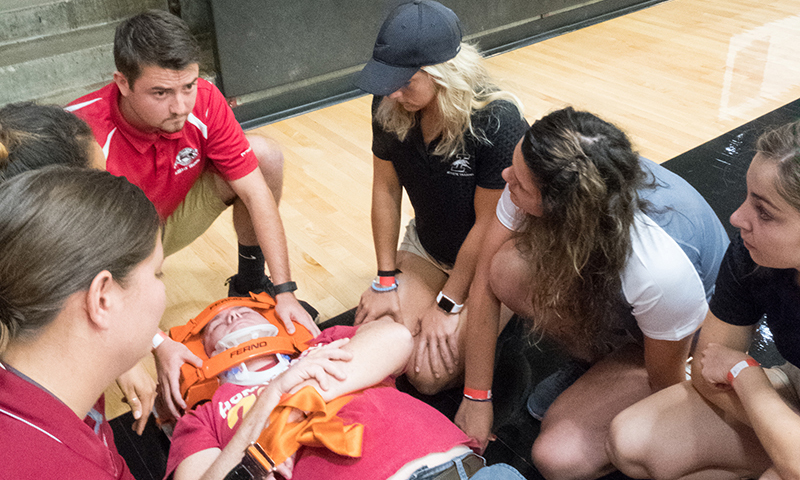IPE is more than a buzzword

Interprofessional education, or IPE, is not just a buzzword in higher education. It is a way to prepare students for the way work is done in the healthcare industry. Nearly any occupational therapist will tell you that the work they do is done in concert with a host of other health disciplines, all working for the best interests of the patient. For that reason, UIndy has been working to incorporate IPE into the OT curriculum.
Interprofessional education is critical in OT education because in clinical practice, we work interprofessionally, said Dr. Alison Nichols. We dont work in silos; we have to be able to communicate with other members of the healthcare team, as well as collaborate with them for the best outcomes for our patients.
Nichols was part of the planning committee for an August 2017 IPE simulation involving undergraduate and graduate students from mulitiple health-related disciplines, including OT, physical therapy, nursing, social work, psychology, and athletic training.
The simulation involved a parent who fell down the stairs at a UIndy basketball game while drunk and sustained an injury to his spine, Nichols said. The OT students observed their student colleagues in action while treating this patient, but they were also able to be actively involved. The MOT students completed a co-evaluation with physical therapy students on the patient and participated in a case conference with physical therapy, nursing, social work, and psychology students to determine where the patient should be discharged to.
This simulation allowed students from each discipline to have a better understanding of the roles and responsibilities of other healthcare team members, as well as gain a respect for what each team member contributes to the patients care.
Its not just UIndy OT students who are learning about IPE. Faculty are involved in learning to better incorporate IPE into their teaching methods. Dr. Brenda Howard attended the Interprofessional Education Collaboratives Fall Institute in October 2017.
It was an incredible experience of learning how other professions approach IPE, Howard said. The experience led me to re-frame my understanding of IPE as not something we add as a band-aid to an already existing OT education. Rather, its a way of thinking that is integral to practicing occupational therapy in the midst of a milieu of all the health professions.
Dr. Sally Wasmuth, another OT faculty member, attended the Interprofessional Education Collaborative Fall Institute in 2016. Armed with what she learned there, Wasmuth organized an interprofessional education and practice (IPE/P) workshop at UIndy in September 2017.
Supported by an internal UIndy vision grant, the purpose of the workshop was to bring together scholars and practitioners to engage and educate students, faculty, community stakeholders, and Community Health Network (CHNw) clinicians on key conceptual and practical aspects of IPE/P.
The workshop was one step toward the realization of UIndy President Rob Manuel’s vision, stated in 2015, for the newly designed Health Pavilion: The UIndy Health Pavilion, located on the campus of UIndy, has technological infrastructure and facilities to provide an integrated learning and practice experience for students, faculty, and healthcare providers.
With the infrastructure in place, this workshop was needed to begin conversations between the different health professions and facilitate the planning of future IPE activities, Wasmuth said.
Workshop keynote speaker Dr. Penelope Moyers introduced human-centered design as a method for creating outstanding IPE programming and provided specific examples of design methods leading to IPE programs, products, and services. Mary Franklin from Case Western Reserve University discussed her team’s implementation of IPE and lessons learned. Several UIndy faculty, including OT faculty Dr. Lori Breeden and Dr. Alison Nichols also presented.
